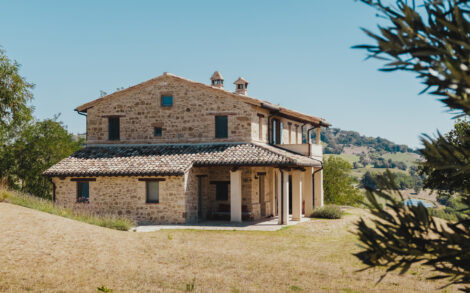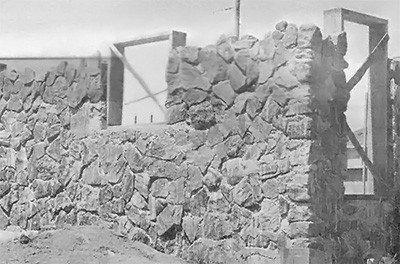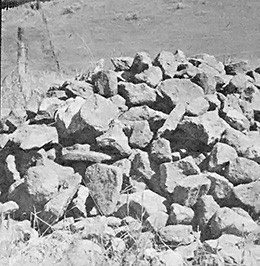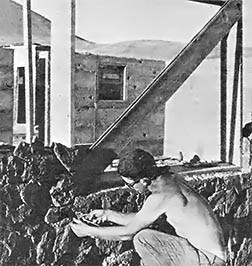Building a rock house offers sustainability, longevity, and unique aesthetic appeal; but how do you actually do it? At rockscapes.net, we provide the insights and resources needed to transform your vision of a sturdy, beautiful stone home into a reality. This guide explores the process, benefits, and considerations for building your own rock house, empowering you to create a lasting legacy with natural stone and offering inspiration for your rock landscaping project.
1. Unearthing the Enduring Appeal: Why Build a Rock House?
Rock houses offer unique advantages, blending natural beauty with structural integrity. The longevity and sustainability of stone construction make it an appealing choice for homeowners.
1.1. A Testament to Time: Durability and Longevity
Stone structures are renowned for their resilience. Unlike conventional building materials that degrade over time, stone stands the test of centuries. According to the National Park Service, many historic stone buildings still stand today, showcasing stone’s lasting power. Opting for stone means investing in a home that will endure for generations.
1.2. Embracing Sustainability: An Eco-Friendly Choice
Using locally sourced stone reduces the carbon footprint associated with transportation. Stone is a natural, abundant material that doesn’t require manufacturing processes that consume energy and produce waste.
1.3. A Symphony of Aesthetics: Natural Beauty and Design Flexibility
The variety of colors, textures, and shapes available in natural stone provides endless design possibilities. Stone can be used to create rustic cabins or modern masterpieces, each uniquely reflecting the builder’s vision.
1.4. The Fortress Within: Fire Resistance and Protection
Stone is inherently fire-resistant, providing a significant safety advantage. In the event of a fire, a stone house offers superior protection compared to wood or other combustible materials. This feature can also lead to lower insurance premiums in some areas.
1.5. A Worthwhile Investment: Increased Property Value
Stone houses often command higher resale values due to their durability, unique aesthetic appeal, and perceived quality.
1.6. Minimal Maintenance: A Hassle-Free Home
Stone requires little to no maintenance, eliminating the need for painting, siding replacement, or repairs. This translates to long-term cost savings and more time to enjoy your home.
1.7. Temperature Regulation: Natural Insulation
Stone’s thermal mass helps regulate indoor temperatures, keeping homes cooler in the summer and warmer in the winter. This natural insulation reduces reliance on heating and cooling systems, saving energy and money.
1.8. A Quiet Retreat: Superior Soundproofing
Stone provides excellent sound insulation, creating a peaceful and quiet indoor environment. This is especially beneficial in urban areas or noisy environments.
 two story stone house
two story stone house
Two-story house made of natural stones with an impressive appearance.
2. Laying the Foundation: Essential Considerations Before You Build
Building a rock house requires careful planning and consideration of various factors. Choosing the right stone and adhering to local regulations are crucial steps.
2.1. Selecting Your Stone: Types and Characteristics
The type of stone you choose will significantly impact the appearance, durability, and cost of your home.
| Stone Type | Characteristics | Applications |
|---|---|---|
| Granite | Extremely durable, resistant to weathering, available in various colors | Foundations, walls, landscaping |
| Limestone | Sedimentary rock, softer than granite, often used for decorative elements | Walls, veneers, paving |
| Sandstone | Another sedimentary rock, known for its warm colors and textured surface | Walls, veneers, paving |
| Slate | Fine-grained, metamorphic rock, known for its ability to be split into thin sheets | Roofing, flooring, wall cladding |
| Fieldstone | Unprocessed stones found on the ground surface, often irregular in shape and size | Walls, foundations, rustic landscaping |
| River Rock | Smooth, rounded stones found in riverbeds, offering a natural and aesthetically pleasing look | Landscaping, decorative walls |
| Flagstone | A type of sedimentary rock that is easily split into flat pieces, making it ideal for paving and walkways. | Patios, walkways, stepping stones |
| Quartzite | A metamorphic rock formed from sandstone, known for its durability and resistance to weathering. | Walls, paving, landscaping |
| Basalt | A dark-colored, volcanic rock that is dense and durable, often used in modern and contemporary designs. | Walls, paving, landscaping |
| Travertine | A type of limestone formed near mineral springs, characterized by its porous texture and warm colors. | Interior and exterior cladding, paving |
| Manufactured Stone Veneer | A lightweight alternative made from concrete or other materials that mimics the look of natural stone. | Exterior and interior walls, fireplaces |
2.2. Navigating Regulations: Permits and Building Codes
Before starting construction, research local building codes and permit requirements. These regulations ensure the safety and structural integrity of your home. Contact your local building department for detailed information.
2.3. Designing Your Dream: Architectural Plans
Consider the overall design and layout of your rock house. Work with an architect or designer to create detailed plans that meet your needs and comply with building codes.
2.4. Budgeting Realistically: Material and Labor Costs
Estimate the cost of materials, labor, and other expenses. Stone can be a cost-effective building material, especially if you can source it locally. However, labor costs can be significant if you hire professional stonemasons.
2.5. Sourcing Your Stone: Local Quarries and Suppliers
Research local quarries and suppliers to find the best quality stone at competitive prices. Visiting a quarry allows you to inspect the stone firsthand and ensure it meets your requirements.
2.6. Preparing the Site: Foundation and Land Grading
Proper site preparation is crucial for a stable and long-lasting foundation. Ensure the ground is properly graded and compacted before pouring the foundation.
2.7. Gathering Your Team: Hiring Contractors and Specialists
Decide whether you will build the rock house yourself or hire contractors. If you choose to hire professionals, select experienced stonemasons, architects, and engineers.
2.8. Considering the Environment: Climate and Location
Consider the climate and environmental conditions in your area. Choose stone that is resistant to weathering, erosion, and temperature fluctuations.
2.9. Planning for Utilities: Plumbing and Electrical Systems
Plan for the installation of plumbing, electrical, and HVAC systems. Ensure these systems are integrated seamlessly into the stone structure.
2.10. Thinking Long-Term: Maintenance and Repairs
Consider the long-term maintenance and repair needs of your rock house. While stone is durable, it may require occasional cleaning or repairs.
3. Building Techniques: From Foundation to Walls
Several techniques can be used to build a rock house, each with its own advantages and disadvantages. Understanding these methods is essential for a successful project.
3.1. Traditional Mortar Construction: The Classic Approach
This method involves laying stones in a bed of mortar, creating a solid and durable wall. Traditional mortar construction requires skill and experience to ensure the stones are properly aligned and the mortar joints are strong.
3.2. Slipform Stone Masonry: A Modern Innovation
Slipforming involves using temporary forms to hold the stones in place while the mortar sets. This technique allows for faster construction and requires less skill than traditional methods.
3.3. Dry Stone Walling: An Ancient Art
Dry stone walls are built without mortar, relying on the interlocking of stones for stability. This technique requires careful stone selection and placement and is best suited for retaining walls and landscaping features.
3.4. Stone Veneer: A Cost-Effective Alternative
Stone veneer involves attaching thin slices of natural or manufactured stone to a structural wall. This method is less expensive than building with solid stone and can be used to create the look of a rock house without the added weight and expense.
3.5. Hybrid Methods: Combining Techniques
Combining different techniques can offer the best of both worlds. For example, you could use traditional mortar construction for the foundation and slipforming for the walls.
3.6. Foundation Construction: Ensuring Stability
The foundation is the most critical part of any building. For a rock house, a concrete foundation is typically used to provide a solid and level base.
3.7. Wall Construction: Laying the Stones
The process of laying the stones involves carefully selecting each stone, applying mortar, and placing it in the wall. Ensure the stones are properly aligned and the mortar joints are consistent.
3.8. Lintels and Arches: Creating Openings
Lintels (horizontal beams) and arches are used to create openings for windows and doors. These elements require careful planning and construction to ensure they can support the weight of the stone above.
3.9. Roofing Options: Completing the Structure
The roof is the final element of the rock house. Consider roofing options that complement the stone walls, such as slate, tile, or metal.
3.10. Insulation and Weatherproofing: Ensuring Comfort
Proper insulation and weatherproofing are essential for a comfortable and energy-efficient rock house. Consider using rigid foam insulation or other materials to minimize heat loss and prevent moisture intrusion.
 black and white photo of a partially constructed stone and wood house
black and white photo of a partially constructed stone and wood house
The structure of a house being constructed with stone and wood materials.
4. Design Inspirations: Rock House Styles and Features
Rock houses can be designed in various styles, from rustic to modern. Exploring different design ideas can help you create a unique and beautiful home.
4.1. Rustic Charm: The Natural Look
Rustic rock houses often feature irregular stones, exposed beams, and natural wood accents. This style emphasizes the natural beauty of the stone and creates a cozy and inviting atmosphere.
4.2. Modern Elegance: Clean Lines and Minimalism
Modern rock houses often incorporate clean lines, minimalist design, and large windows. This style combines the durability and beauty of stone with contemporary architectural elements.
4.3. Blending Styles: Eclectic Designs
Combining different styles can create a unique and personalized rock house. For example, you could blend rustic elements with modern features or incorporate architectural details from different cultures.
4.4. Stone Accents: Incorporating Rock into Existing Structures
If you’re not ready to build an entire rock house, consider adding stone accents to an existing structure. Stone veneer, fireplaces, and landscaping features can enhance the beauty and value of your home.
4.5. Rock Walls: Interior and Exterior Design
Rock walls can be used to create stunning interior and exterior features. Consider using stone walls to define spaces, create focal points, or add texture and character to your home.
4.6. Fireplaces: A Cozy Focal Point
A stone fireplace is a classic feature in many rock houses. It provides warmth, ambiance, and a natural focal point for the living room.
4.7. Landscaping: Integrating the House with Nature
Landscaping is an essential part of any rock house design. Consider using native plants, stone pathways, and water features to create a harmonious and natural setting.
4.8. Patios and Walkways: Extending Living Spaces Outdoors
Stone patios and walkways can extend your living spaces outdoors. Consider using flagstone, pavers, or gravel to create inviting and functional outdoor areas.
4.9. Water Features: Adding Tranquility
Water features, such as fountains and ponds, can add tranquility and beauty to your rock house landscape. Consider using natural stone to create a seamless and harmonious design.
4.10. Unique Features: Arches, Towers, and More
Consider incorporating unique architectural features, such as arches, towers, and turrets, to create a one-of-a-kind rock house. These elements can add character and visual interest to your home.
5. Stone Sourcing and Cost Considerations: Making Informed Decisions
The cost of building a rock house varies depending on the type of stone, construction method, and location. Sourcing stone locally can significantly reduce costs.
5.1. Quarry Direct: Benefits of Buying from the Source
Buying stone directly from a quarry can save money and ensure you get the best quality materials. Visit local quarries to inspect the stone and discuss your project requirements.
5.2. Recycled Stone: An Environmentally Friendly Option
Using recycled stone is an environmentally friendly and cost-effective option. Reclaimed stone can add character and history to your rock house.
5.3. Estimating Stone Needs: Calculating Quantity
Accurately estimating the amount of stone you need is essential for staying within budget. Consult with a stonemason or supplier to calculate the quantity of stone required for your project.
5.4. Budget Breakdown: Materials vs. Labor
Understand the breakdown of costs between materials and labor. Labor costs can be significant, especially if you hire experienced stonemasons.
5.5. DIY vs. Professional: Weighing the Options
Decide whether you will build the rock house yourself or hire professionals. DIY construction can save money but requires significant time, skill, and effort.
5.6. Financing Options: Loans and Grants
Explore financing options, such as construction loans and grants, to help cover the cost of building your rock house.
5.7. Long-Term Savings: Energy Efficiency and Maintenance
Consider the long-term savings associated with a rock house, such as reduced energy bills and minimal maintenance costs.
5.8. Negotiating Prices: Tips for Getting the Best Deals
Negotiate prices with suppliers and contractors to get the best deals on materials and labor.
5.9. Cost-Effective Designs: Simple vs. Complex
Choose a design that fits your budget. Simple designs are typically less expensive to build than complex designs with intricate details.
5.10. Value Engineering: Optimizing Costs
Value engineering involves finding ways to reduce costs without compromising the quality or functionality of the rock house.
 black and white photo of a pile of building stones
black and white photo of a pile of building stones
A stockpile of natural stones, ready to be used for construction of building.
6. Expert Tips and Tricks: Ensuring a Successful Build
Building a rock house can be challenging, but with the right knowledge and preparation, you can ensure a successful build.
6.1. Working with Stone: Safety Precautions
Always wear safety glasses, gloves, and other protective gear when working with stone. Stone can be heavy and sharp, so take precautions to avoid injuries.
6.2. Mortar Mixing: Achieving the Right Consistency
Properly mixing mortar is essential for a strong and durable wall. Follow the manufacturer’s instructions and use the right amount of water to achieve the desired consistency.
6.3. Stone Placement: Techniques for Stability
Carefully select and place each stone to ensure stability and structural integrity. Interlock the stones and stagger the joints to create a strong and visually appealing wall.
6.4. Weather Considerations: Building in Different Climates
Consider the weather conditions in your area. In cold climates, protect the mortar from freezing. In hot climates, keep the stones and mortar moist to prevent cracking.
6.5. Tools and Equipment: Essential Stonemasonry Tools
Invest in essential stonemasonry tools, such as a stone hammer, chisel, trowel, level, and measuring tape. These tools will make the job easier and more efficient.
6.6. Sealing and Waterproofing: Protecting Your Investment
Seal and waterproof the stone walls to protect them from moisture damage. Use a high-quality sealant designed for natural stone.
6.7. Drainage Solutions: Preventing Water Damage
Proper drainage is essential for preventing water damage to the foundation and walls. Install drainage systems to divert water away from the rock house.
6.8. Working with Contractors: Communication and Oversight
Communicate clearly with contractors and provide oversight to ensure the project is completed to your satisfaction.
6.9. Building Codes: Compliance and Inspections
Ensure your rock house complies with local building codes and undergoes inspections to verify its safety and structural integrity.
6.10. Long-Term Maintenance: Preserving Your Stone House
Regularly inspect the stone walls for cracks or damage and make repairs as needed. Clean the stone periodically to remove dirt and grime.
7. Common Mistakes to Avoid: Learning from Others
Avoiding common mistakes can save you time, money, and frustration. Learn from the experiences of other rock house builders.
7.1. Poor Foundation: The Importance of a Solid Base
A weak or poorly constructed foundation can lead to structural problems. Ensure the foundation is properly designed and built to support the weight of the stone walls.
7.2. Incorrect Mortar Mix: Weakening the Structure
Using the wrong mortar mix can weaken the structure and lead to premature failure. Follow the manufacturer’s instructions and use the right type of mortar for your project.
7.3. Neglecting Drainage: Water Damage and Erosion
Neglecting drainage can lead to water damage, erosion, and foundation problems. Install drainage systems to divert water away from the rock house.
7.4. Ignoring Building Codes: Legal and Safety Issues
Ignoring building codes can lead to legal issues and safety hazards. Ensure your rock house complies with local regulations and undergoes inspections.
7.5. Poor Stone Selection: Choosing the Wrong Materials
Choosing the wrong type of stone can lead to durability and aesthetic problems. Select stone that is appropriate for your climate, design, and budget.
7.6. Lack of Planning: Inefficient Construction
A lack of planning can lead to inefficient construction, delays, and cost overruns. Develop a detailed plan before starting your project.
7.7. Cutting Corners: Sacrificing Quality for Cost
Cutting corners to save money can compromise the quality and longevity of your rock house. Invest in quality materials and workmanship.
7.8. Inadequate Insulation: Energy Inefficiency
Inadequate insulation can lead to energy inefficiency and high heating and cooling bills. Properly insulate the walls and roof to minimize heat loss and gain.
7.9. Poor Ventilation: Moisture Problems and Mold
Poor ventilation can lead to moisture problems and mold growth. Ensure your rock house is properly ventilated to prevent these issues.
7.10. Neglecting Maintenance: Gradual Deterioration
Neglecting maintenance can lead to gradual deterioration of the stone walls and other features. Regularly inspect and maintain your rock house to preserve its beauty and value.
Construction worker filling stone between form boards.
8. Maintaining Your Rock House: Ensuring Longevity and Beauty
Proper maintenance is essential for preserving the beauty and longevity of your rock house. Regular inspections and cleaning can prevent problems and extend the life of your home.
8.1. Regular Inspections: Identifying Potential Issues
Inspect the stone walls, foundation, and roof regularly for cracks, damage, or signs of water intrusion. Address any issues promptly to prevent further damage.
8.2. Cleaning Techniques: Removing Dirt and Grime
Clean the stone walls periodically to remove dirt, grime, and stains. Use a mild detergent and a soft brush to avoid damaging the stone.
8.3. Sealing and Waterproofing: Protecting Against Moisture
Reapply sealant and waterproofing as needed to protect the stone walls from moisture damage. Follow the manufacturer’s instructions and use a high-quality sealant designed for natural stone.
8.4. Repairing Cracks: Addressing Structural Issues
Repair cracks in the stone walls promptly to prevent water intrusion and structural problems. Use mortar or other appropriate materials to fill the cracks.
8.5. Preventing Erosion: Landscaping and Drainage
Maintain proper landscaping and drainage to prevent erosion around the foundation and walls. Divert water away from the rock house to minimize water damage.
8.6. Pest Control: Protecting Against Insects and Animals
Implement pest control measures to protect against insects and animals that can damage the stone walls or other features.
8.7. Vegetation Management: Preventing Root Damage
Manage vegetation around the rock house to prevent roots from damaging the foundation or walls. Trim or remove trees and shrubs that are too close to the structure.
8.8. Weather Protection: Preparing for Extreme Conditions
Prepare your rock house for extreme weather conditions, such as hurricanes, floods, or blizzards. Secure loose stones, clear debris, and take other precautions to minimize damage.
8.9. Professional Maintenance: Hiring Experts When Needed
Hire professional stonemasons or contractors for major repairs or maintenance tasks that are beyond your skill level.
8.10. Long-Term Planning: Budgeting for Maintenance
Budget for long-term maintenance costs to ensure your rock house remains in good condition for generations to come.
9. Rock House FAQs: Answers to Your Burning Questions
Here are some frequently asked questions about building a rock house, providing valuable insights and information.
9.1. Is it more expensive to build a rock house?
Not necessarily. While initial material costs can vary, locally sourced stone can be very affordable, even free for gathering on your own property. Long-term, stone’s durability reduces maintenance costs.
9.2. How long does it take to build a rock house?
Construction time depends on the size and complexity of the design, as well as the builder’s experience. A simple rock house can be built in a few months, while a more elaborate one may take a year or more.
9.3. Can I build a rock house myself?
Yes, with proper planning, research, and skill development, you can build a rock house yourself. However, it’s essential to have some experience with construction and stonemasonry, or be willing to learn.
9.4. What are the best types of stone to use for building a house?
Granite, limestone, sandstone, and fieldstone are all excellent choices for building a rock house, depending on your location, budget, and design preferences.
9.5. Are rock houses energy-efficient?
Yes, stone’s thermal mass helps regulate indoor temperatures, reducing the need for heating and cooling. Proper insulation and weatherproofing can further enhance energy efficiency.
9.6. Do I need special permits to build a rock house?
Yes, you will need to obtain building permits from your local government before starting construction. Research local building codes and permit requirements to ensure compliance.
9.7. How do I find a good stonemason?
Ask for referrals from friends, family, or other contractors. Check online reviews and visit completed projects to assess the stonemason’s skills and experience.
9.8. Can I add stone accents to an existing house?
Yes, stone veneer, fireplaces, and landscaping features can be added to an existing house to enhance its beauty and value.
9.9. How do I maintain a rock house?
Regular inspections, cleaning, sealing, and repairs are essential for maintaining a rock house. Address any issues promptly to prevent further damage.
9.10. What are the benefits of building with stone compared to other materials?
Stone is durable, fire-resistant, pest-resistant, and requires little maintenance. It also offers a unique aesthetic appeal and can increase property value.
 black and white photo of a man using tie ends to clean concrete on a…
black and white photo of a man using tie ends to clean concrete on a…
Contractor man working on a building project with stone.
10. Ready to Build? Rockscapes.net is Your Partner in Stone
Building a rock house is an ambitious project, but the result is a durable, beautiful, and unique home that will last for generations.
Ready to explore the possibilities of rock landscaping? Visit rockscapes.net to discover design ideas, learn about different types of stone, and connect with experts who can help you bring your vision to life.
At rockscapes.net, we are dedicated to helping you create the perfect landscape. Contact us today to start your journey toward a more beautiful and sustainable outdoor living space.
Address: 1151 S Forest Ave, Tempe, AZ 85281, United States
Phone: +1 (480) 965-9011
Website: rockscapes.net.